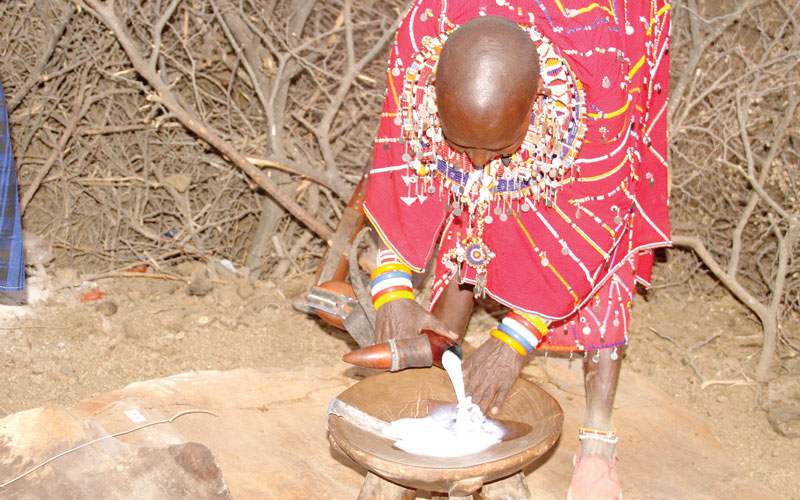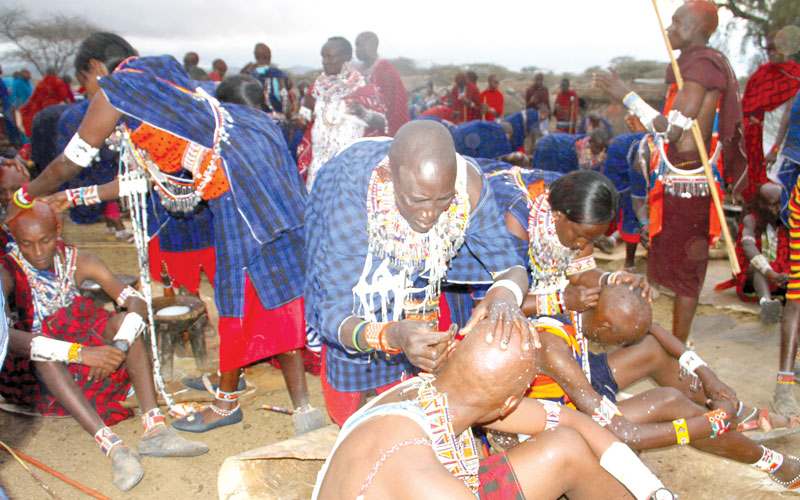The making of a Maasai man

We stand transfixed as a middle-aged woman, clad in ceremonial traditional shuka, pours milk on the head of a young man seated on a wooden stool. The mood is sombre, tense.
We can only imagine what is going through the man’s mind as he goes through a vital transition in his life.
We are at Olgulului village, in Kajiado county for the Eunoto, one of the three rites a Maasai man must undergo. It involves shaving off morans’ hair to transform them to seniors, warriors or junior elders.
The occasion is marked with pomp and colour, as many morans, scattered across the country and world converge in the village.
From nearby villages, some ride in on boda boda as others walk. From the city, they stream in on SUVs and hired saloon cars. How else would everyone know the city boys are in town?
Death of differences
However, this is a place where all differences die: the learned comrades who have been slaying in the city come and mingle freely with their peers who dropped out of school in pursuit of the warrior way of life in the bush.
Off go the jeans and favourite football jerseys, designer jackets and the latest Jordans and Timberland boots.
On come shukas and nkinyera or akala (rubber sandals). They sing and jump, crack jokes and talk about girls, politics, and football. And now with technology, take selfies together.
By dusk, the boma is filled with hundreds of excited warriors, singing, jumping and chanting in a circle, which gets bigger as the night goes on.
It sets the stage for things to come, and for those yet to paint their heads with red ochre and draw patterns on their bodies, they use this chance to do so. 
Occasionally, one or two morans will throw a fit or enter into a trance and singing will be interrupted as a few other morans hold him until he finally calms down. So it goes into the night.
Dawn comes with an entourage of lorries from different villages. On them are the morans’ mothers, carrying the traditional stool, gourds of milk and newly bought razor blades.
They are here for a vital part of the process: shaving their son’s heads and with it a decade of uptightness and gang-like way of life.
As the golden sun rises from the east, it is a golden moment for the warriors.
The shaving starts and as morans patiently wait in line, the eagerness in their eyes is replaced with sadness and tears as they watch locks of hair fall to the ground. Milk signifies life for the Maasai, and it is used to lubricate the morans’ heads.
Now with clear-shaven heads, the bond that held the morans together as the Iltuati ageset has been broken. And finally, one can eat and bathe alone!
Elders’ blessings
What follows is the assembly of the morans in their hundreds. They squat in two neat rows as elders, carrying milk in the empukuri (gourd), sprinkle milk on the morans using grass as they pass in between the rows. The morans chant naaai (amen) in unison after the elders utter each blessing.
For 60-year-old mzee Richard Tipape Oloitiptip, it is a day of great significance: his six sons, including Letema Tipape, are graduating.
“You see all that excitement? They are still morans, though senior now. There are little changes in the procedure: what our ancestors did is exactly what has happened today.
However, one can see the influence of modernity in our young men who have gone to school. 
The church has also affected it because there is a small number of people who might miss out completely,” says the man, who had his own ceremony in 1978.
Unlike in his days where the morans would have to put their education and work on hold to attend it, the event is now scheduled during holidays and weekends when almost everyone is available.
His son, Letema, says culture is important to him and his fellow morans. “In our culture, a man is defined by orkereti (culture), and it is important that it be passed on from one generation to another.
This is what holds our community together. I, myself, will observe it and pass it to my children and their children. As they say, there is no river without a source,” he says.
Having travelled all the way from Nairobi where he works, Shadrack Saibulu says it is a big day for him.
His guardian, Kenneth Ole Sayiei, beams with sheer joy, as his son is shaven. He belongs to the Irkileani age set, which forms majority of the fathers whose sons are graduating.
“I have been waiting ten years for this occasion. Today, we can take milk from our mothers’ gourd, as we wait for the last graduation, Olng’esherr, where we will be given meat.
This is something that every moran must undergo. Failure to do so has its own repercussions, including being treated as a loner and stranger by your own peers,” says Saibulu.
Those who are not able to join the merriment will hold their own eunoto at home where a number of morans of his ageset attend. 
The event is also marked with slaughtering of a goat and the usual pomp and colour.
10 year gap
Once the elders give the blessings, excitement rends the air as the morans exit the boma, singing and jumping. It is a new dawn for them.
Outside, they throw their specially prepared sticks into the air, mimicking the throwing spears. Few hours later, the main action moves to orpul, where meat is roasted.
Here, no woman is allowed as it is considered an abomination. They remain at the boma, wrapping their paraphernalia, singing and chatting as they wait for food. The elders wait for the Olaikulu (chest) and ilaras (ribs), under preparation as they sip emomoi, a traditional drink.
The merry making will continue until the next day, where the Lagwananis (the chiefs) will arrive and be received from Monduli in Tanzania.
The excited morans will line up and greet the Laigwanani, whose hand they believe has blessings from the Oloiboni (traditional healer) and also marks the continuity of culture from the last generation to the current.
The process will repeat itself after another ten years, where the morans will once again assemble and graduate to elders.
The chain will never stop, especially with the United Nations Educational, Scientific and Cultural Organisation (Unesco) having announced that it will protect this rite of passage among many others from the Maasai community.
The UN’s cultural body has declared these rites as ‘intangible cultural heritage in need of urgent safeguarding’.
The inscription also includes rites such as the Enkipaata, the induction of boys leading to initiation and Olng’esherr, the meat-eating ceremony that marks the end of moranism and the beginning of eldership.







